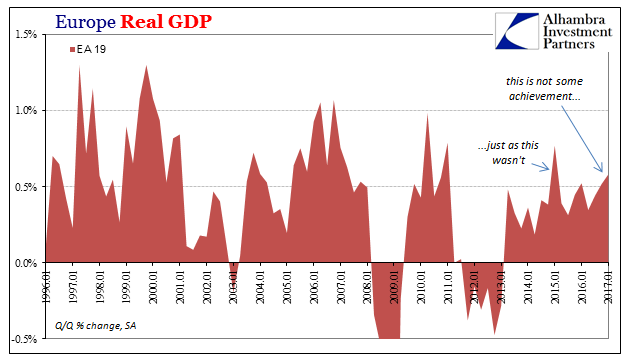Europe is as we all are. Ben Bernanke wrote a few years ago that his tenure at the Fed must have been a success in his view because the US economy didn’t perform as badly as Europe’s. As usual, this technically true comparison is for any meaningful purpose irrelevant. For one, the European economy underperformed before 2008, too. Second, after 2008, really August 9, 2007, there isn’t nearly as much difference as Bernanke tried to claim.
In Q1 2017, at least, the Europeans are trying to celebrate, as contrary to this longer-term arrangement their economy outperformed ours by some distance. Real GDP growth was revised upward to +0.6% quarter over quarter, the highest growth rate in two years. And it is that framing which becomes highlighted in all mainstream commentary, so as to emphasize what sounds like a positive distinction.
Europe’s economy is, however, like its US counterpart still contracting. The estimates all have plus signs and in linear terms it appears as if growth has occurred, but by what truly matters both only trail further and further behind not each other but where the world needs these economies to be to get out of the trap.


European GDP has been positive in real terms for each of the past sixteen quarters through Q1 2017. And in those four years of “growth”, the level of estimated output has only fallen further behind than it already was when it exited re-recession after 2012. At the start of that renewed contraction, Real GDP was 9% behind the pre-crisis baseline; at its end in the first quarter of 2013, -16.5%. As of the latest “encouraging” GDP report and upward revision, real GDP is 23.6% below trend. This is continuing non-linear contraction.
The prior trend-line is not some mathematical trick, it is an estimate of what is needed in terms of economic output and performance to get back to normal and out of dangerous stagnation and depression. It is not a precise estimate by any means, nor does it need to be when the level of GDP misses by such a wide mark. We don’t need to know exactly how far behind Europe’s economy is, as the US’s is, in order to safely conclude that it is by a huge margin. Output increases, but never makes up for what it too often loses.














Leave A Comment